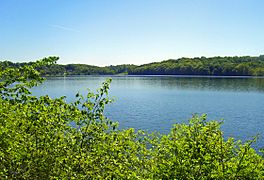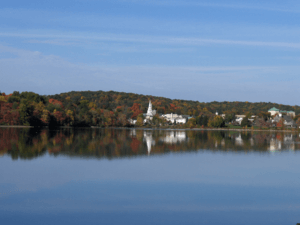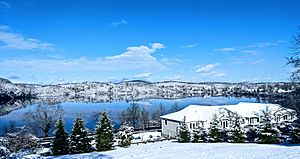Lake Gleneida facts for kids
Quick facts for kids Lake Gleneida |
|
|---|---|

From east shore, looking south
|
|
| Location | Carmel Hamlet, New York |
| Coordinates | 41°25′12″N 73°41′00″W / 41.42000°N 73.68333°W |
| Type | reservoir |
| Catchment area | 313.6 acres (126.9 ha) |
| Basin countries | United States |
| Max. length | 3,500 ft (1,100 m) |
| Max. width | 2,000 ft (610 m) |
| Surface area | 168 acres (68 ha) |
| Average depth | 48 ft (15 m) |
| Max. depth | approx. 100 ft (30 m) |
| Water volume | 8,042 acre⋅ft (9,920,000 m3) |
| Surface elevation | 505 ft (154 m) |
Lake Gleneida is a large reservoir (a man-made lake) located in the town of Carmel, in Putnam County, New York. It was once a smaller natural pond called Shaw's Pond. In 1870, New York City built a dam to make it bigger. The lake grew to about 168 acres (68 ha) (68 hectares). This was done to help supply water to New York City. Lake Gleneida is now part of the city's water supply system. It is known as a "controlled lake" within the Croton Watershed.
Contents
Exploring Lake Gleneida's Location
Lake Gleneida is shaped a bit like a heart. It sits just southwest of downtown Carmel. The lake is surrounded by grassy parks on its south and east sides. Woods cover the other sides.
Several roads go around the lake. NY 301 runs along the north shore. It goes up to where it meets NY 52. This intersection is across from the Putnam County courthouse. Route 52 then follows the eastern shore for a short distance. It ends where it meets US 6. US 6 continues around the southern shore of the lake. There is no main road along the western side. However, a local street called Glenvue Drive goes along the top of a 545-foot (166 m)-high ridge there.
How Deep is Lake Gleneida?
The lake fills a small dip in a hilly area. The bottom of the lake drops quickly from the shoreline. It reaches a depth of over 100 feet (30 m) (30 meters) in the middle. The average depth is about 48 feet (15 m) (15 meters). The lake usually holds about 2.6 billion US gallons (9,800,000 m3) (9.8 billion liters) of water.
There are no small streams that flow into Lake Gleneida. A dam and a spillway are located on the northwest side of the lake. Water from the lake flows into the West Branch Reservoir. This reservoir is also part of New York City's water system. Any extra water that New York City does not need flows over the spillway. This water then goes into the West Branch Croton River. This river's water is later collected by the Croton Falls Reservoir.
The Story of Lake Gleneida

Lake Gleneida was first known as Shaw's Pond. It was named after an early landowner. The pond has been a part of the Carmel area since 1814. That's when Carmel became the main town for Putnam County. The pond quickly became a popular place for boating and fishing.
The name "Lake Gleneida" started appearing on maps around 1840. People living nearby soon wanted a grander name for it. In 1852, a group of local residents chose the name Lake Gleneida. New York City bought the rights to the lake around 1895. They removed any houses that were built too close to the water.
Fun Activities at Lake Gleneida
The New York City Department of Environmental Protection (DEP) owns Lake Gleneida. It is one of three "controlled lakes" in the city's water system. This means the DEP can take water from the lake because they own it.
If you want to use the lake for fun, you need to follow DEP rules. You can go fishing, ice fishing, and boating. But you must have a valid DEP permit. You also need a fishing license from the New York State Department of Environmental Conservation. Swimming is not allowed in the lake.
Boats used in Lake Gleneida must only be used in this lake. This rule helps stop the spread of tiny creatures called zebra mussels. These mussels can harm the lake's environment. In 2005, some people were worried because many boats were left on the shore during the winter. The town of Carmel thought this looked messy. They were spending money to make the downtown area look nicer. The DEP worked with boat owners to move their boats to storage areas. This helped keep them out of sight from downtown.




